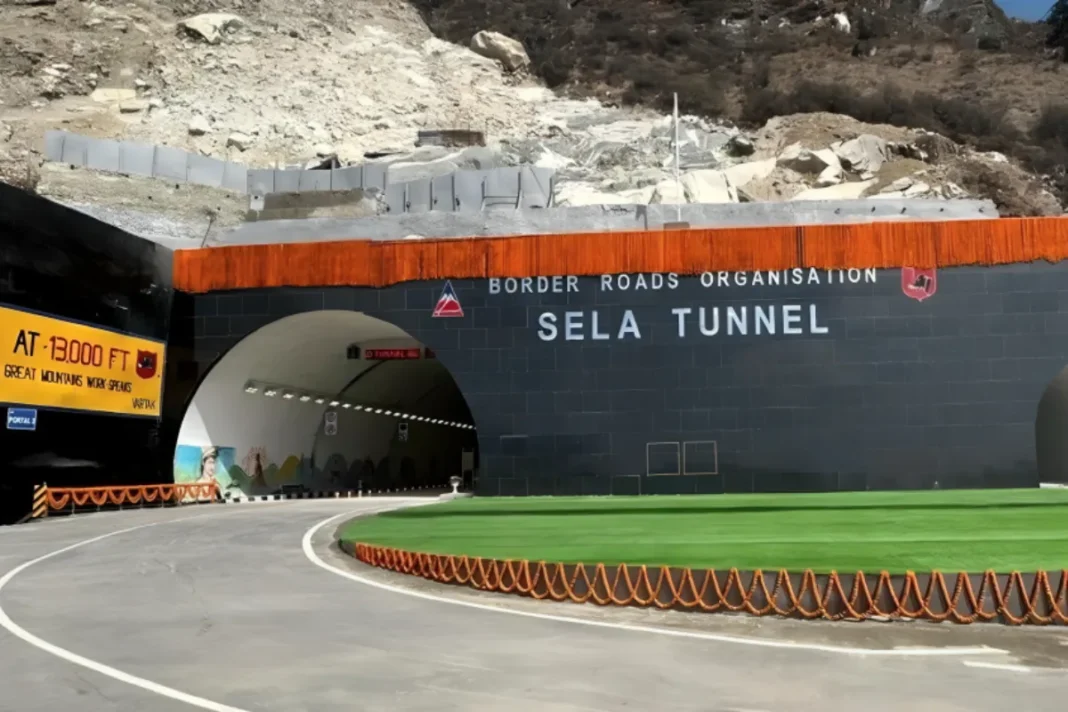Prime Minister Narendra Modi inaugurated the strategically vital Sela Tunnel today, marking a significant milestone in India’s infrastructure development efforts across the northeastern region. The inauguration ceremony, held in Itanagar, also highlighted a series of projects totaling Rs 55,600 crore, aimed at bolstering connectivity and economic growth in Manipur, Meghalaya, Nagaland, Sikkim, Tripura, and Arunachal Pradesh.
Constructed by the Border Roads Organisation (BRO), the Sela Tunnel stands tall at an altitude of 13,000 ft, providing all-weather connectivity to Tawang through the challenging Sela pass on the Balipara-Chariduar-Tawang Road in Arunachal Pradesh. With an approximate cost of Rs 825 crore, this engineering marvel overcomes the hurdles posed by difficult terrain and adverse weather conditions, ensuring seamless connectivity to the strategically significant Tawang region.
Development Overview
The foundation stone of the Sela Tunnel was laid by Prime Minister Narendra Modi on February 9, 2019, with construction commencing on April 1, 2019. Despite facing daunting challenges such as difficult terrain and adverse weather conditions, including freezing temperatures and heavy snowfall, the tunnel has been completed in just five years. The first blast occurred on October 31, 2019, heralding the beginning of this transformative project.
Specifications of the Sela Tunnel
The Sela Tunnel comprises two tunnels, with Tunnel 1 spanning 980m and the Twin Tube Tunnel stretching 1,555m long, along with 8.6km of approach and link roads. Additionally, an escape tube adjacent to the main one ensures adherence to international safety norms, facilitating the movement of rescue vehicles and evacuation of stranded individuals during emergencies.
Securing the Borders – A Strategic Lifeline
For decades, the lack of proper infrastructure in Arunachal Pradesh posed a significant challenge along the Line of Actual Control (LAC) with China. The treacherous Sela Pass, the only route to the strategically crucial Tawang region, was prone to harsh winters and landslides, hindering troop movement and hindering military preparedness. The Sela Tunnel cuts through this vulnerability, offering an all-weather lifeline. By bypassing the Sela Pass, the tunnel ensures the swift movement of troops and supplies irrespective of weather conditions. This significantly strengthens India’s defence capabilities in the region, deterring any potential threats and ensuring a swift response in case of emergencies.
Tourism Potential
The Sela Tunnel’s impact extends far beyond national security. It serves as a gateway to unlock the immense tourism potential of Tawang. Previously, the arduous journey through the Sela Pass, often blocked by snow and landslides, discouraged travel. The tunnel not only reduces travel time by an hour but also eliminates dependence on weather conditions. This opens doors for tourists to explore the pristine beauty of Tawang, its rich cultural heritage, and the warmth of its people. With improved accessibility, tourism is poised to flourish, bringing economic prosperity to the region. Local communities can benefit from increased trade, job creation in the hospitality sector, and a boost to the overall economy.
Overcoming Immense Challenges
Building a tunnel at such an altitude is no small feat. The Border Roads Organisation (BRO) deserves immense credit for overcoming seemingly insurmountable challenges. Sub-zero temperatures plummeting to -10°C, frequent blizzards, and unpredictable water ingress threatened to derail the project. However, the BRO’s unwavering dedication, coupled with cutting-edge technology and the sheer grit of civilian laborers, ensured the tunnel’s completion in a remarkable five years.
Technology Used In Sela Tunnel’s Construction
The Sela Tunnel has been constructed using the New Austrian Tunneling Method (NATM), widely accepted and utilized in tunnel construction worldwide, particularly suitable for Himalayan geology. This method, based on the philosophy of ‘Build As You Go,’ leverages the inherent strength of the surrounding rock mass to support the tunnel structure. Over the course of the project, it required over 90 lakh man-hours, with an average of around 650 personnel and laborers working diligently every day for the past five years.
The scale of the project is evident in the significant quantities of resources utilized, including 71,000 metric tonnes of cement, 5,000 metric tonnes of steel, and 800 metric tonnes of explosives. Supported by 162 plants and machinery dedicated to its construction, the Sela Tunnel project adheres to the highest quality standards, guided by a meticulously prepared quality assurance plan in strict accordance with IRC SP 91 and MoRTH guidelines.
Furthermore, the tunnel boasts state-of-the-art safety features, including a ventilation system to maintain air quality, along with a sophisticated electro-mechanical system featuring a jet fan ventilation system, fire fighting devices, CIE norms-based illumination system, and SCADA-controlled monitoring systems. These advanced technologies ensure the safety, efficiency, and sustainability of the tunnel infrastructure, meeting the diverse needs of its users while adhering to stringent quality and safety standards.
A Brighter Future for Arunachal Pradesh
The Sela Tunnel is more than just an infrastructure project; it’s a symbol of India’s commitment to progress and development in its easternmost state. It signifies the nation’s resolve to bridge the gap between its geographical borders and its economic potential. The improved connectivity will not only enhance national security but also empower the people of Arunachal Pradesh. With better access to healthcare, education, and essential services, the tunnel paves the way for a brighter future for the region and its inhabitants.


